Leaching Characteristics of Exogenous Cl− in Rain-Fed Potato Fields and Residual Estimation Model Validation
Abstract
1. Introduction
2. Results
2.1. Effect of Cl Application Rate on Cl− Migration in Soil
2.2. Effect of Rainfall on Cl− Distribution in Soil Profile
2.3. Effects of Rainfall and Cl Application Rate on Cl− Leaching Efficiency
2.4. Validation of Model with Field Experiments
2.5. Influence of Basal Application of KCl on Potato Tuber Yield
3. Discussion
3.1. Effects of Rainfall on Exogenous Cl− Transport and Leaching in Soils with Varying Textures
3.2. Validation of Cl− Retention Estimation Model
3.3. Response of Cl− Transport Dynamics to Potato Growth Stages and Tuber Yield
4. Materials and Methods
4.1. Site Characteristics and Experimental Materials
4.2. Cl Treatment and Application
4.3. Field Management
4.4. Soil Sample Collection
4.5. Soil Test Methods
4.6. Index Calculation
4.7. Model Validation Indices
4.8. Statistical Analysis
5. Conclusions
Author Contributions
Funding
Data Availability Statement
Conflicts of Interest
Abbreviations
| RMSE | Root Mean Square Error |
| NRMSE | Normalized Root Mean Square Error |
| PBIAS | Percentage Bias |
| DAS | Days After Sowing |
| MRT | Multiple Range Test |
| ISE | Ion-Selective Electrode |
| ISSS | International Standard for Soil Texture Classification |
| SRB | Sulfate-Reducing Bacteria |
Appendix A
| Texture Name | Particle Size Composition (%) | |||
|---|---|---|---|---|
| Clay (<0.002 mm) | Silt (0.002–0.02 mm) | Sand (0.02–2 mm) | ||
| Sandy soil | Sandy soil or loamy sand | 0–15 | 0–15 | 85–100 |
| Loam | Sandy loam | 0–15 | 0–45 | 55–85 |
| Loam | 0–15 | 30–45 | 40–55 | |
| Silty loam | 0–15 | 45–100 | 0–55 | |
| Clay loam | Sandy clay loam | 15–25 | 0–30 | 55–85 |
| Clay loam | 15–25 | 20–45 | 30–55 | |
| Silty clay loam | 15–25 | 45–85 | 0–40 | |
| Clay soil | Sandy clay | 25–45 | 0–20 | 55–75 |
| Loamy clay | 25–45 | 0–45 | 10–55 | |
| Silty clay | 25–45 | 45–75 | 0–30 | |
| Clay | 45–65 | 0–35 | 0–55 | |
| Heavy clay | 65–100 | 0–35 | 0–35 | |
References
- Geilfus, C.M. Chloride in soil: From nutrient to soil pollutant. Environ. Exp. Bot. 2018, 157, 299–309. [Google Scholar] [CrossRef]
- Miller, J.; Beasley, B.; Drury, C.; Zebarth, B. Accumulation and redistribution of residual chloride, nitrate, and soil test phosphorus in soil profiles amended with fresh and composted cattle manure containing straw or wood-chip bedding. Can. J. Soil Sci. 2011, 91, 969–984. [Google Scholar] [CrossRef]
- Borggaard, O. Influence of iron oxide on the non-specific anion (chloride) adsorption by soil. J. Soil Sci. 1984, 35, 71–78. [Google Scholar] [CrossRef]
- Dai, Z.; He, S.; Chen, A.; Xiao, L.; Mei, G. Experimental Investigation on chloride transport in semi-buried concrete exposed to seawater wet-dry cycles in coastal soil environment. Case Stud. Constr. Mater. 2024, 20, e03360. [Google Scholar] [CrossRef]
- Liu, X.; Hu, C.; Zhu, Z.; Riaz, M.; Liu, X.; Dong, Z.; Liu, Y.; Wu, S.; Tan, Z.; Tan, Q. Migration of Chlorine in Plant-Soil-Leaching System and Its Effects on the Yield and Fruit Quality of Sweet Orange. Front. Plant Sci. 2021, 12, 744843. [Google Scholar] [CrossRef]
- Sun, L.; Yuan, L.; Fu, Q.; Nie, X.; Yu, H.; Tang, J.; Dong, L. Effects of rainfall on Cl− leaching efficiency and its spatial distribution in soils with different textures. J. Northeast. Agric. Univ. 2022, 53, 27–38. [Google Scholar] [CrossRef]
- Hutsch, B.W.; Keipp, K.; Glaser, A.K.; Schubert, S. Potato plants (Solanum tuberosum L.) are chloride-sensitive: Is this dogma valid? J. Sci. Food Agric. 2018, 98, 3161–3168. [Google Scholar] [CrossRef]
- Wilmer, L.; Pawelzik, E.; Naumann, M. Comparison of the Effects of Potassium Sulphate and Potassium Chloride Fertilisation on Quality Parameters, Including Volatile Compounds, of Potato Tubers After Harvest and Storage. Front. Plant Sci. 2022, 13, 920212. [Google Scholar] [CrossRef]
- Zhao, W.; Faust, F.; Schubert, S. Potassium is a potential toxicant for Arabidopsis thaliana under saline conditions. J. Plant Nutr. Soil Sci. 2020, 183, 455–467. [Google Scholar] [CrossRef]
- Hütsch, B.; Heid, A.; Keipp, K.; Schubert, S. Can fertilization of potato (Solanum tuberosum L.) with potassium sulfate cause oxidative stress in the plants? J. Plant Nutr. Soil Sci. 2024, 187, e00127. [Google Scholar] [CrossRef]
- Light, S.E.; Sullivan, D.M.; Horneck, D.A. Timing of potassium chloride application effect on soil and potato uptake of chloride. Agrosystems Geosci. Environ. 2022, 5, e20301. [Google Scholar] [CrossRef]
- Oketch, A.; Ngeno, J.; Ngode, L.; Chiveu, J.; Churu, H. Effects of Source and Rates of Potassium Fertilizer on Yield Traits and Potassium Use Efficiency of Potato in a Kenyan Ferralsol. Asian J. Soil Sci. Plant Nutr. 2023, 9, 152–160. [Google Scholar] [CrossRef]
- Campana, P.; Stridh, B.; Hörndahl, T.; Svensson, S.-E.; Zainali, S.; Ma Lu, S.; Zidane, T.E.K.; Luca, P.; Amaducci, S.; Colauzzi, M. Experimental Results, Integrated Model Validation, and Economic Aspects of Agrivoltaic Systems at Northern Latitudes; Aalto University: Helsinki, Finland, 2023; Volume 437. [Google Scholar]
- Li, Z.; Cheng, Q.; Chen, L.; Zhai, W.; Zhang, B.; Mao, B.; Li, Y.; Ding, F.; Zhou, X.; Chen, Z. Novel spectral indices and transfer learning model in estimat moisture status across winter wheat and summer maize. Comput. Electron. Agric. 2025, 229, 109762. [Google Scholar] [CrossRef]
- Saso, J.K.; Parkin, G.W.; Drury, C.F.; Lauzon, J.D.; Reynolds, W.D. Chloride leaching in two Ontario soils: Measurement and prediction using HYDRUS-1D. Can. J. Soil Sci. 2012, 92, 285–296. [Google Scholar] [CrossRef]
- Szabó, A.; Gribovszki, Z.; Jobbagy, E.G.; Balog, K.; Bidló, A.; Tóth, T. Subsurface accumulation of CaCO3 and Cl− from groundwater under black locust and poplar plantations. J. For. Res. 2018, 30, 1353–1361. [Google Scholar] [CrossRef]
- Zhang, Q.; Waheed, A.; Aishajiang, A.; Xu, H.; Kuerban, A.; Muhammad, M.; Ali, S. Copper sulfate-induced stress in Spinach: Metabolic pathway disruption and plant response. Sci. Hortic. 2024, 337, 113575. [Google Scholar] [CrossRef]
- Teakle, N.; Tyerman, S. Mechanisms of Cl transport contributing to salt tolerance. Plant Cell Environ. 2009, 33, 566–589. [Google Scholar] [CrossRef]
- Burns, I. Model for predicting redistribution of salts applied to fallow soils after excess rainfall or evaporation. J. Soil Sci. 2006, 25, 165–178. [Google Scholar] [CrossRef]
- Su, F.; Wu, J.; Wang, D.; Zhao, H.; Wang, Y.; He, X. Moisture movement, soil salt migration, and nitrogen transformation under different irrigation conditions: Field experimental research. Chemosphere 2022, 300, 134569. [Google Scholar] [CrossRef]
- Xie, L.; Li, Y.; Huang, P.; Hipsey, M.; Zhang, M.; Zhang, Z. Soil macropores induced by plant root as a driver for vertical hydrological connectivity in Yellow River Delta. J. Plant Ecol. 2024, 17, rtae019. [Google Scholar] [CrossRef]
- Gyssels, G.; Poesen, J.; Bochet, E.; Li, Y. Chapter 12—Impact of plant roots on the resistance of soils to erosion by water: A review. In Water-Soil-Vegetation Nexus and Climate Change; Wang, X., Ed.; Elsevier: Amsterdam, The Netherlands, 2024; pp. 345–372. [Google Scholar]
- Wang, Y.; Liu, X.; Wang, L.; Li, H.; Zhang, S.; Yang, J.; Liu, N.; Han, X. Effects of Long-Term Application of Cl-Containing Fertilizers on Chloride Content and Acidification in Brown Soil. Sustainability 2023, 15, 8801. [Google Scholar] [CrossRef]
- Barrow, N.J. Reaction of Anions and Cations with Variable-Charge Soils. In Advances in Agronomy; Elsevier: Amsterdam, The Netherlands, 1986; Volume 38, pp. 183–230. [Google Scholar]
- Mao, Z.; Li, J.; He, G.a.; Di, T. China Chloride-Containing Fertilizers; China Agriculture Press: Beijing, China, 2001. [Google Scholar]
- Reynolds, D.; Drury, C.; Parkin, G.; Lauzon, J.; Saso, J.; Zhang, T.; Liu, K.; Welacky, T.; Yang, X.; Tan, C.; et al. Solute dynamics and the Ontario nitrogen index: I. Chloride leaching. Can. J. Soil Sci. 2016, 96, 105–121. [Google Scholar] [CrossRef]
- Simunek, J.J.; Jarvis, N.; Van Genuchten, M.; Gärdenäs, A. Review and comparison of models for describing non-equilibrium and preferential flow and transport in the vadose zone. J. Hydrol. 2003, 272, 14–35. [Google Scholar] [CrossRef]
- Konzett, M.; Strauss, P.; Schmaltz, E. The not-so-micro effects of in-furrow micro-dams and cover crops on water and sediment retention in potato fields. Soil Tillage Res. 2023, 235, 105911. [Google Scholar] [CrossRef]
- Berdouki, A.A.; Besharat, S.; Zeinalzadeh, K.; Cruz, C. The effect of soil texture, layering and water head on the infiltration rate and infiltration model accuracy. Irrig. Drain. 2024, 36, 456–468. [Google Scholar] [CrossRef]
- Helle, T.; Nordal, S.; Aagaard, P.; Lied, O. Long-term-effect of potassium chloride treatment on improving the soil behavior of highly sensitive clay—Ulvensplitten, Norway. Can. Geotech. J. 2016, 53, 410–422. [Google Scholar] [CrossRef]
- Luo, L.; Lin, H.; Halleck, P. Quantifying Soil Structure and Preferential Flow in Intact Soil Using X-ray Computed Tomography. Soil Sci. Soc. Am. J.—SSSAJ 2008, 72, 1058–1069. [Google Scholar] [CrossRef]
- Li, R.; Chen, L.; Shao, M.A.; Huang, L.; Pei, Y.; Zhang, Y. Cl− transport and its influencing factors in soil as affected by soil texture and vegetation cover in loess plateau. Acta Pedol. Sin. 2021, 58, 1190–1201. [Google Scholar]
- Pigna, M.; Violante, A. Adsorption of Sulfate and Phosphate on Andisols. Commun. Soil Sci. Plant Anal. 2006, 34, 2099–2113. [Google Scholar] [CrossRef]
- Singh, B.R. Sulfate sorption by acid forest soils: 2. Sulfate adsorption isotherms with and without organic matter and oxides of aluminum and iron. Soil Sci. 1984, 138, 294–297. [Google Scholar] [CrossRef]
- Li, M.; Yao, J.; Wang, Y.; Sunahara, G.; Duran, R.; Liu, J.; Liu, B.; Liu, H.; Ma, B.; Li, H.; et al. Contrasting response strategies of sulfate-reducing bacteria in a microbial consortium to As3+ stress under anaerobic and aerobic environments. J. Hazard. Mater. 2023, 465, 133052. [Google Scholar] [CrossRef] [PubMed]
- Shen, Y.; Wang, L.; Cao, Q.; Kariuki, J.; Luo, C. Differential analysis and unified predictive modeling of capillary rise in sodium chloride and sodium sulfate saline soils. Arabian J. Geosci. 2025, 18, 127. [Google Scholar] [CrossRef]
- Edwards, P.J. Sulfur Cycling, Retention, and Mobility in Soils: A Review; Northeastern Research Station, Forest Service, U.S. Department of Agriculture: Newtown Square, PA, USA, 1998. [Google Scholar]
- Addiscott, T.; Rose, D.; Bolton, J. Chloride leaching in the Rothamsted drain gauges: Influence of rainfall pattern and soil structure. J. Soil Sci. 1978, 29, 305–314. [Google Scholar] [CrossRef]
- Joshi, M.; Fogelman, E.; Belausov, E.; Ginzberg, I. Potato root system development and factors that determine its architecture. J. Plant Physiol. 2016, 205, 113–123. [Google Scholar] [CrossRef]
- Kirchgesser, J.; Hazarika, M.; Bachmann-Pfabe, S.; Dehmer, K.; Kavka, M.; Uptmoor, R. Phenotypic variation of root-system architecture under high P and low P conditions in potato (Solanum tuberosum L.). BMC Plant Biol. 2023, 23, 68. [Google Scholar] [CrossRef]
- Iwama, K. Physiology of the Potato: New Insights into Root System and Repercussions for Crop Management. Potato Res. 2008, 51, 333–353. [Google Scholar] [CrossRef]
- Zinta, R.; Tiwari, J.; Buckseth, T.; Thakur, K.; Goutam, U.; Kumar, D.; Challam, C.; Bhatia, N.; Poonia, A.; Naik, S.; et al. Root system architecture for abiotic stress tolerance in potato: Lessons from plants. Front. Plant Sci. 2022, 13, 926214. [Google Scholar] [CrossRef]
- Poulton, P.; Johnston, A.; White, R. Plant-available soil phosphorus. Part I: The response of winter wheat and spring barley to Olsen P on a silty clay loam. Soil Use Manag. 2013, 29, 4–11. [Google Scholar] [CrossRef]
- Speirs, S.; Reuter, D.; Peverill, K.; Brennan, R. Making Better Fertiliser Decisions for Cropping Systems in Australia: An overview. Crop Pasture Sci. 2013, 64, 417–423. [Google Scholar] [CrossRef]
- Colomb, B.; Debaeke, P.; Jouany, C.; Nolot, J. Phosphorus management in low input stockless cropping systems: Crop and soil responses to contrasting P regimes in a 36-year experiment in southern France. Eur. J. Agron. 2007, 26. [Google Scholar] [CrossRef]
- Nie, X.; Li, J.; Yuan, L.; Tang, J.; Fu, Q.; Zhang, J.; Sun, L. Effects of potassium chloride application on the chlorine content of potato and dynamic chlorine critical values. J. Plant Nutr. Fertil. 2024, 30, 1745–1757. [Google Scholar] [CrossRef]
- Spaargaren, O.; Deckers, J. The World Reference Base for Soil Resources. In Soils of Tropical Forest Ecosystems; Springer: Berlin/Heidelberg, Germany, 1998; pp. 21–28. [Google Scholar]
- Bao, S. Soil Agrochemical Analysis, 3rd ed.; China Agriculture Press: Beijing, China, 2000. [Google Scholar]
- Jarvis, N. A review of non-equilibrium water flow and solute transport in soil macropores: Principles, controlling factors and consequences for water quality. Eur. J. Soil Sci. 2020, 71, 279–302. [Google Scholar] [CrossRef]
- Bittelli, M.; Pellegrini, S.; Olmi, R.; Andrenelli, M.C.; Simonetti, G.; Borrelli, E.; Morari, F. Experimental evidence of laser diffraction accuracy for particle size analysis. Geoderma 2022, 409, 115627. [Google Scholar] [CrossRef]
- Moriasi, D.; Arnold, J.; Van Liew, M.; Bingner, R.; Harmel, R.D.; Veith, T. Model Evaluation Guidelines for Systematic Quantification of Accuracy in Watershed Simulations. Trans. ASABE 2007, 50, 885–900. [Google Scholar] [CrossRef]
- Danielescu, S.; Macquarrie, K.; Nyiraneza, J.; Zebarth, B.; Sharifi-Mood, N.; Grimmett, M.; Main, T.; Levesque, M. Development and Validation of a Crop and Nitrate Leaching Model for Potato Cropping Systems in a Temperate–Humid Region. Water 2024, 16, 475. [Google Scholar] [CrossRef]
- Wu, K.; Zhao, R. Soil texture classification and its application in China. Acta Pedol. Sin. 2019, 56, 227–241. [Google Scholar] [CrossRef]
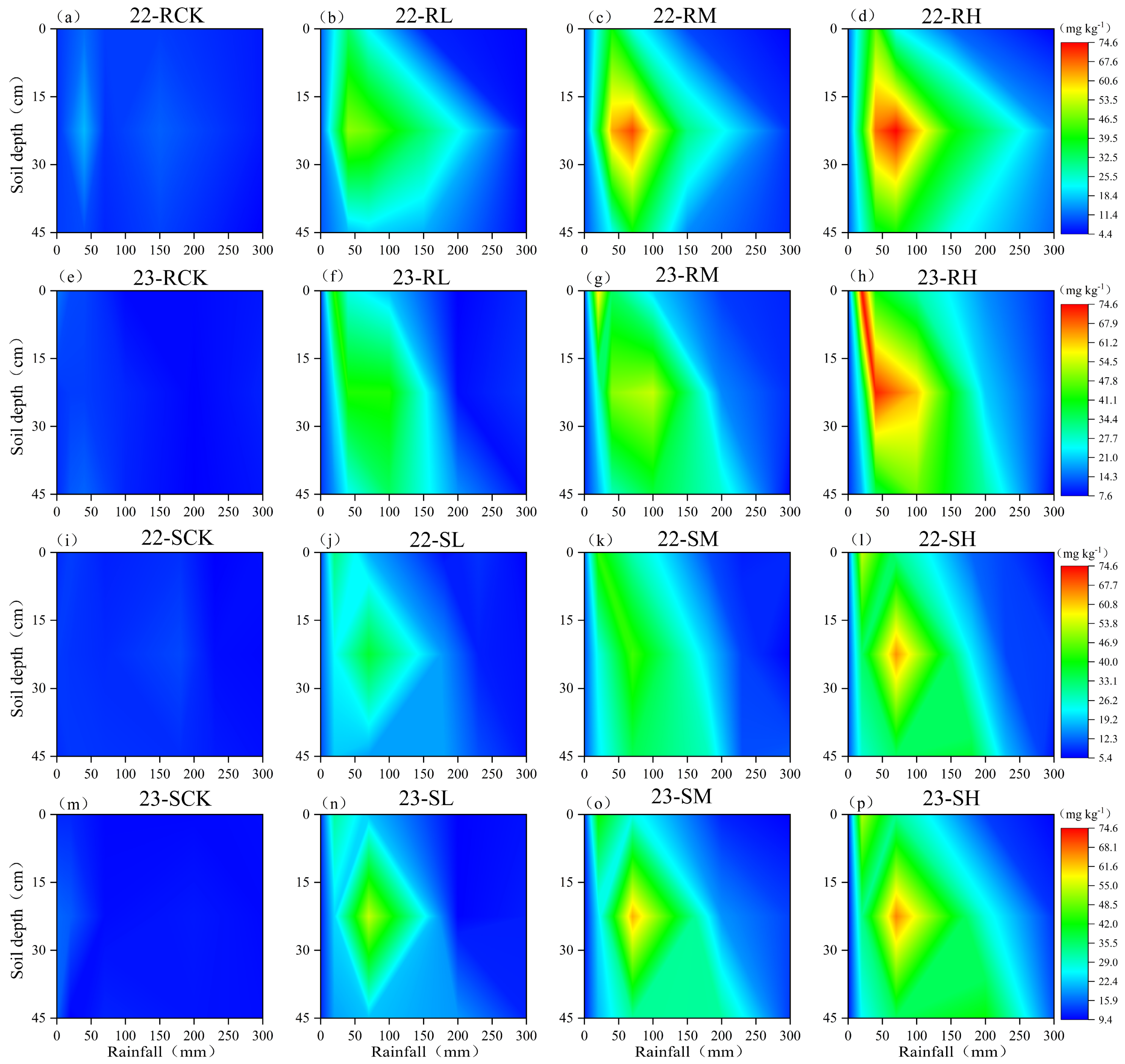
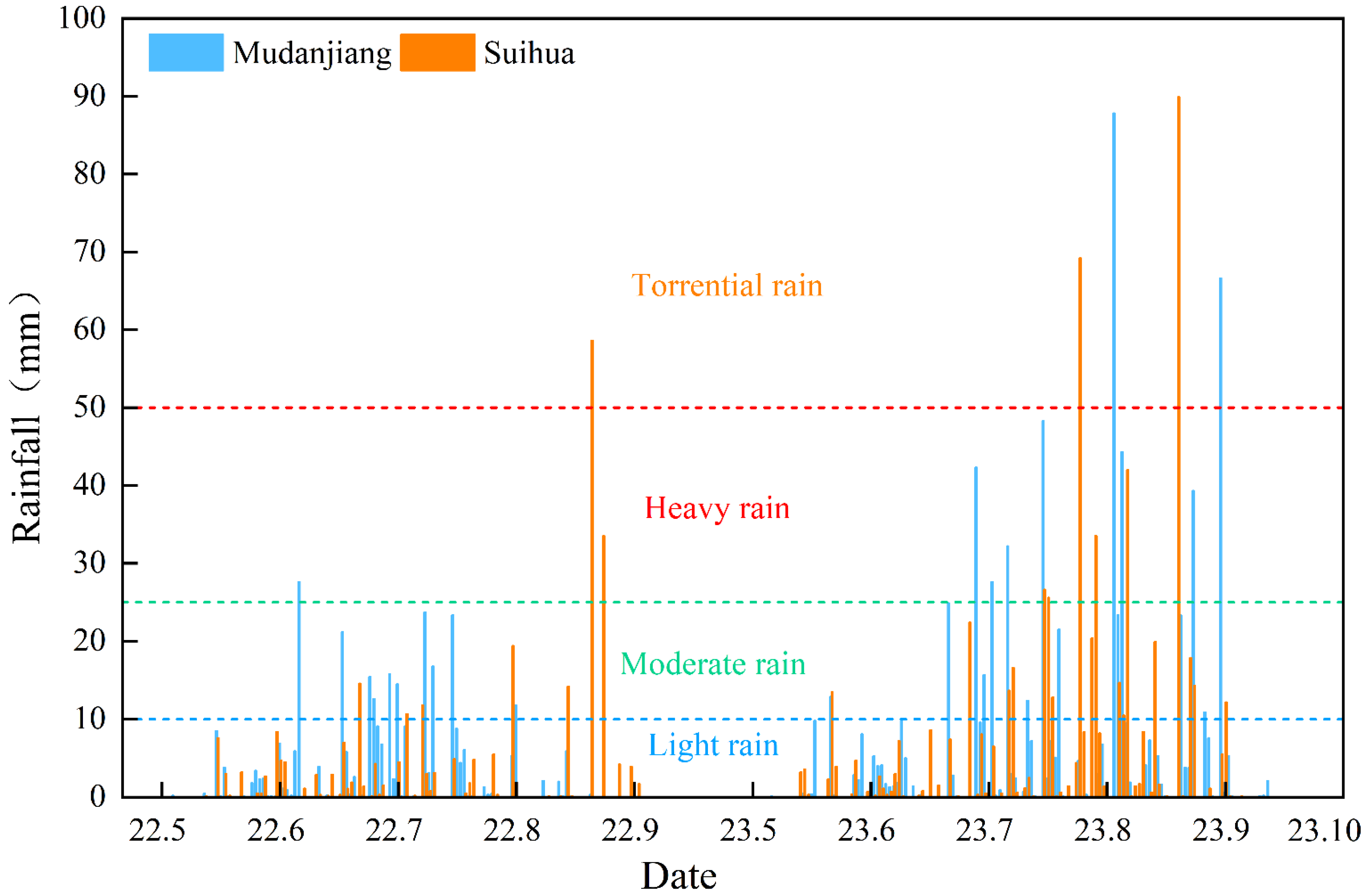
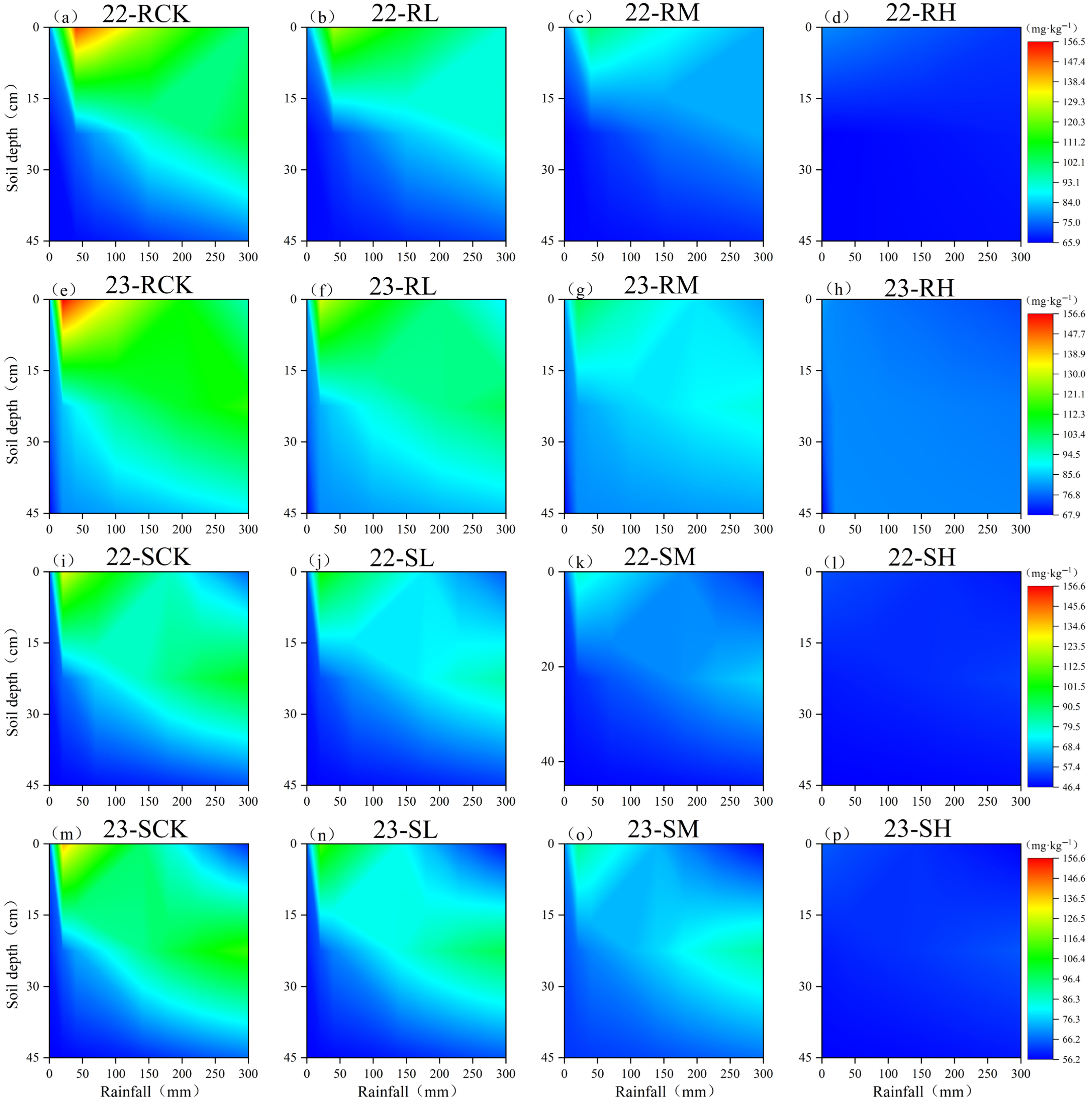
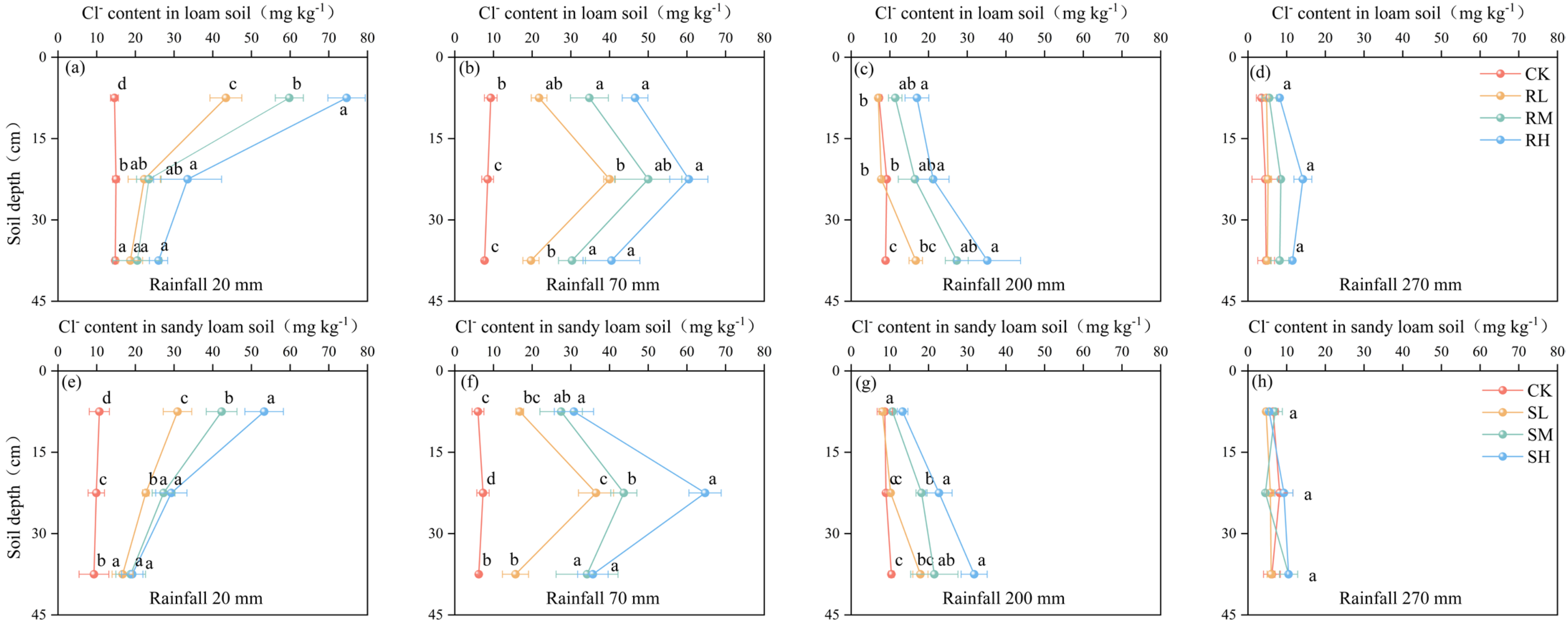

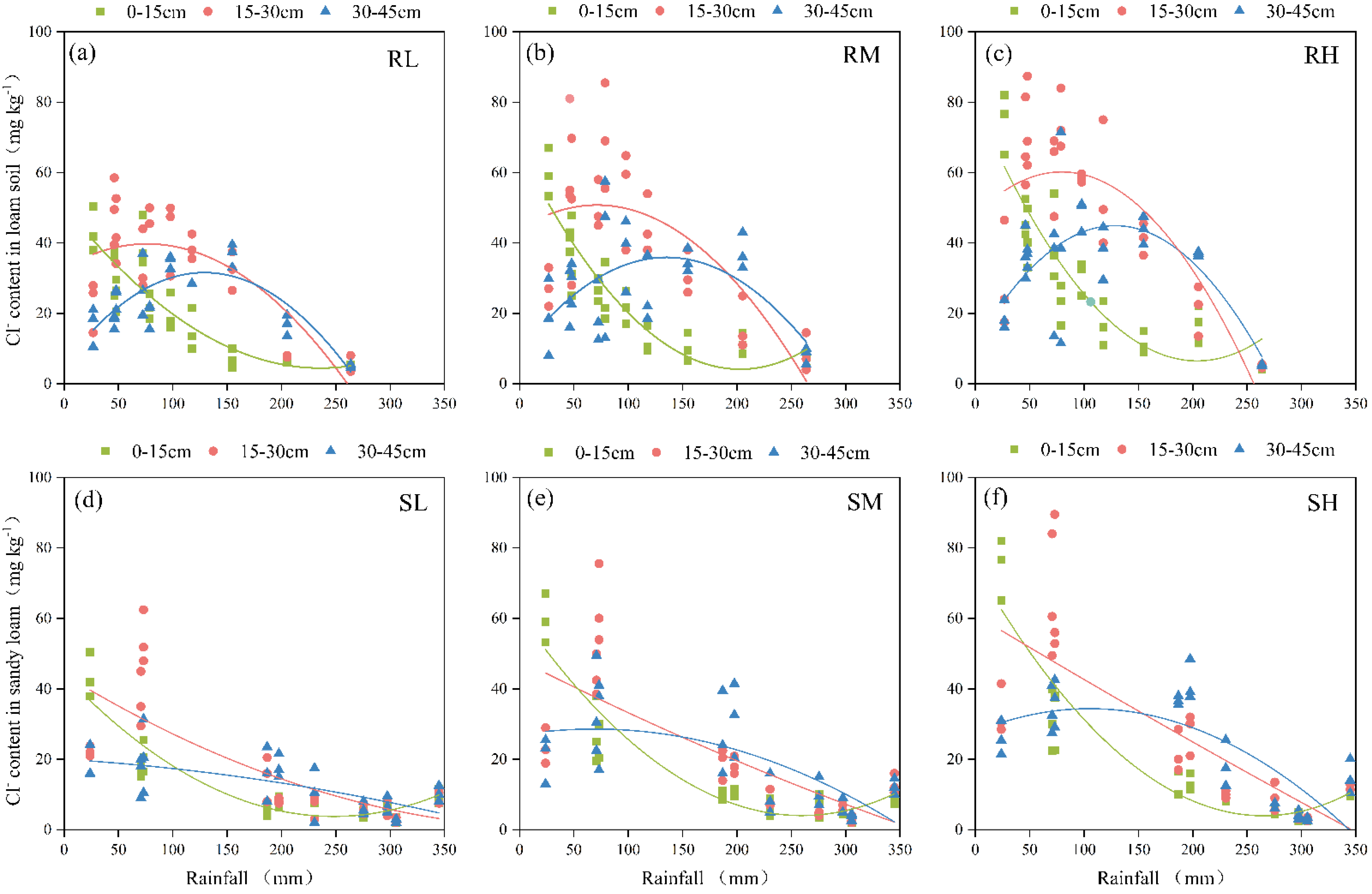

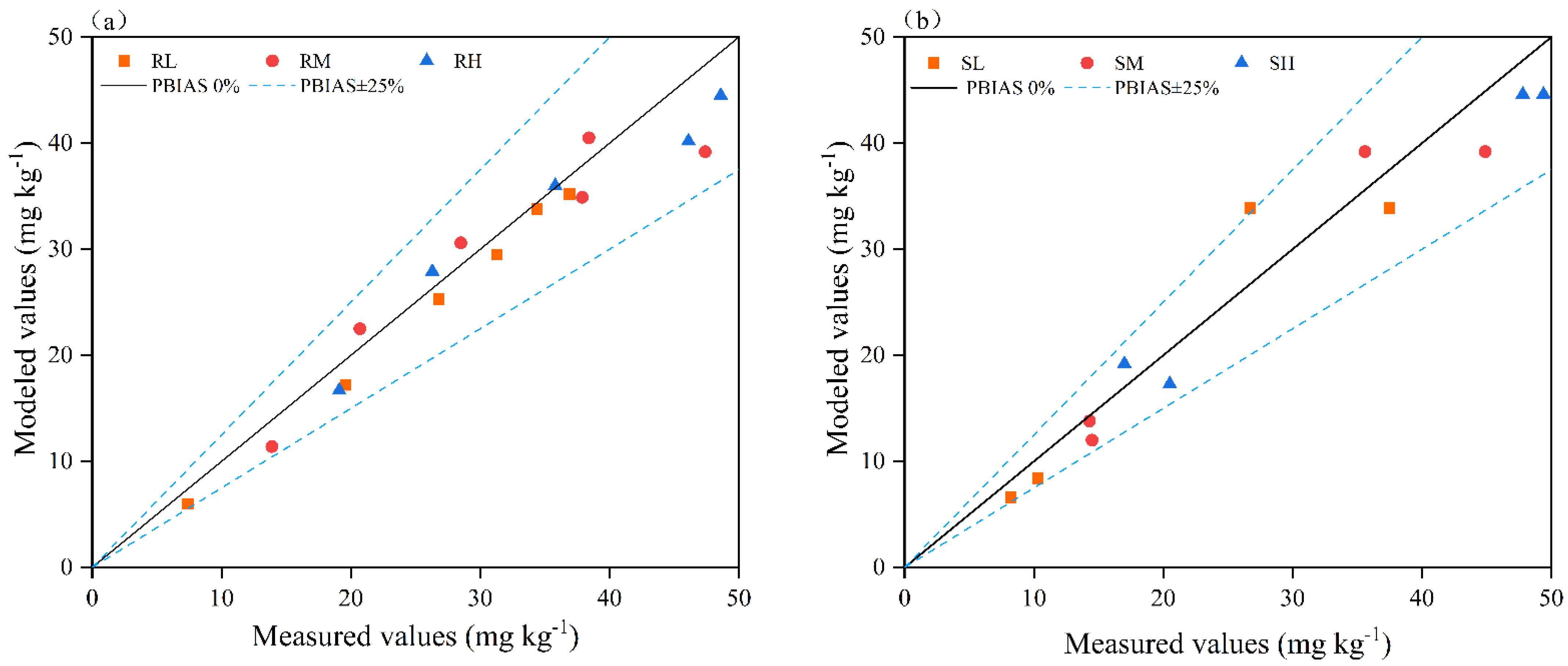
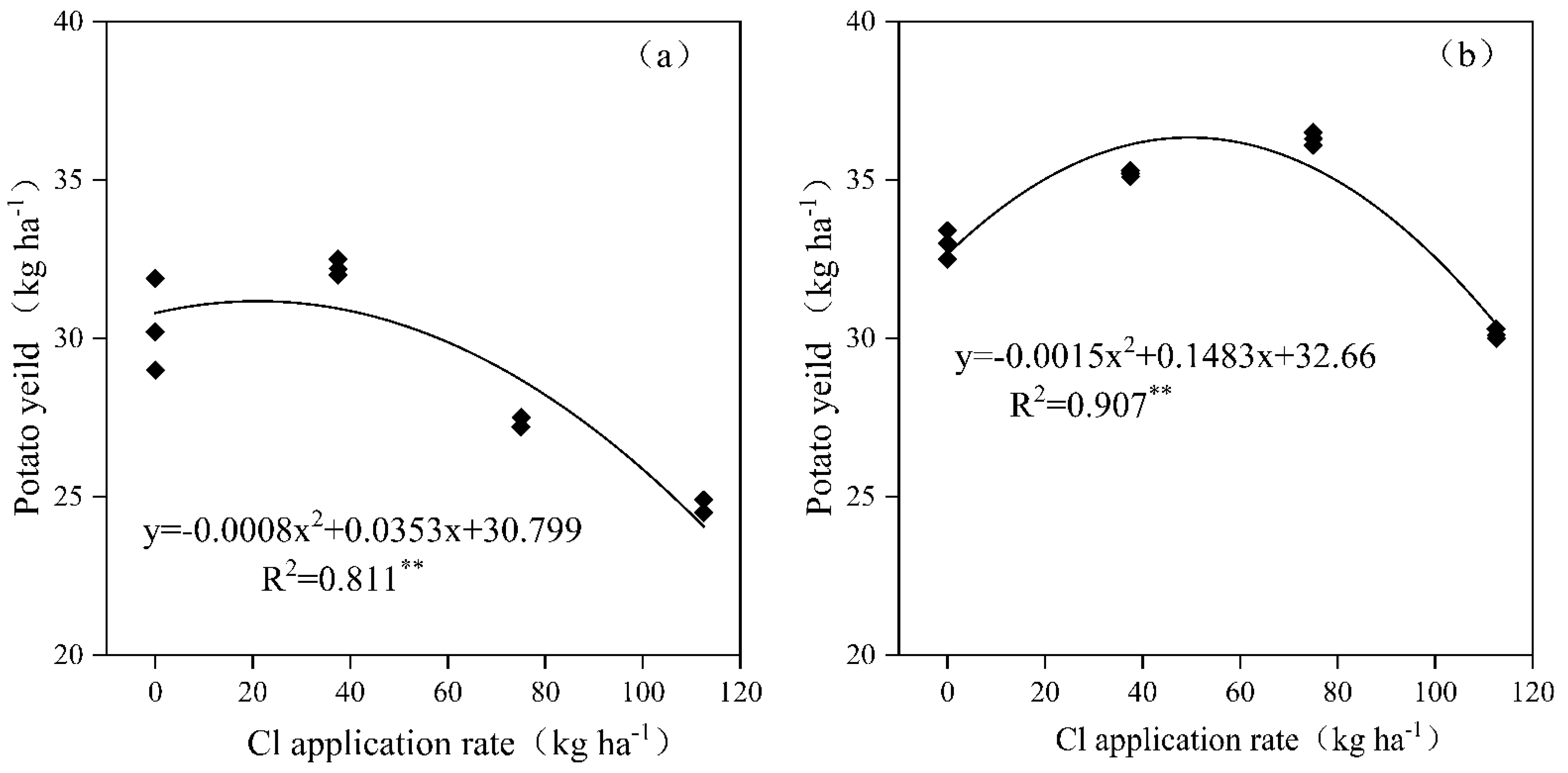
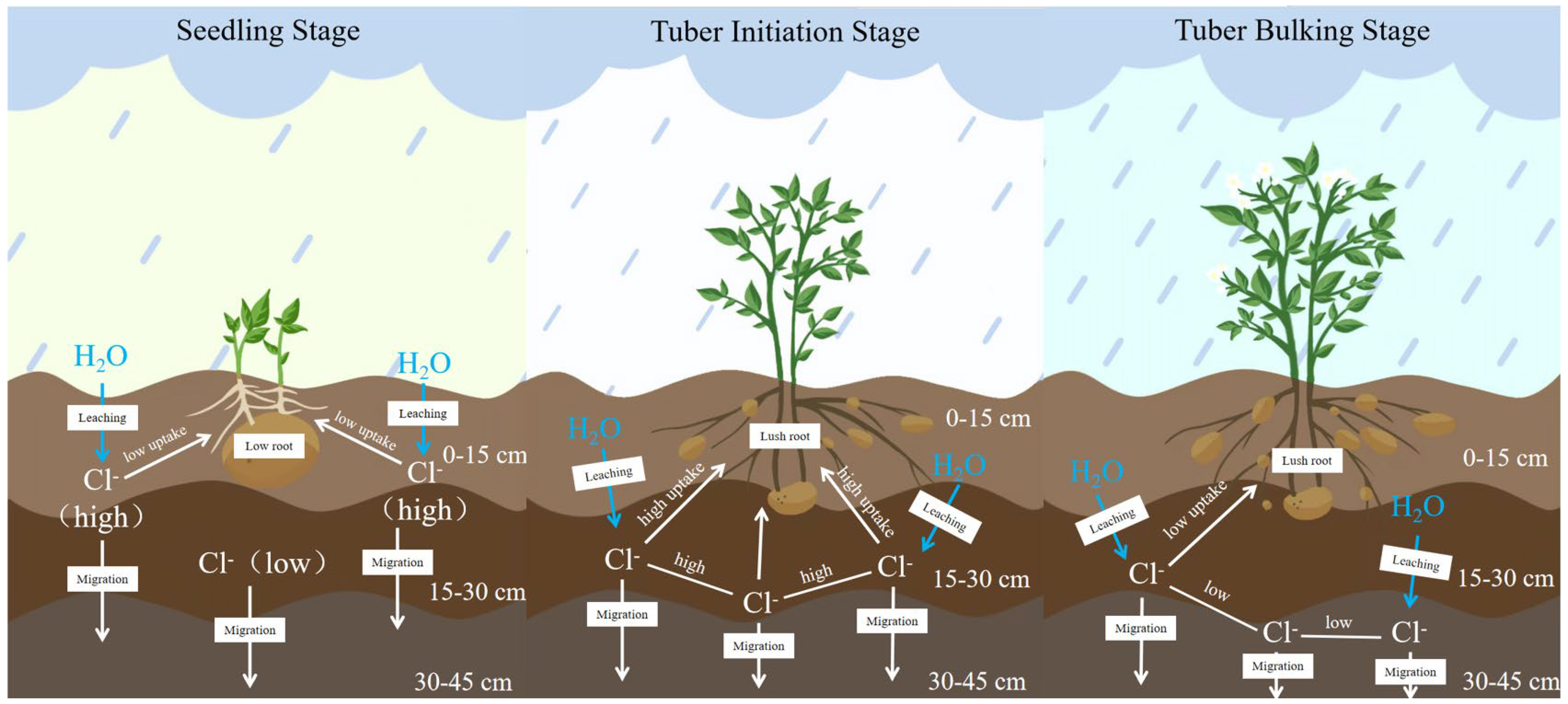
| Treatment | Soil Depth (cm) | Loam Soil (R) | Sandy Loam Soil (S) | ||
|---|---|---|---|---|---|
| Regression Equation | r | Regression Equation | r | ||
| ClL | 0–15 | y = (4.55 × 10−4)x2 − 0.27x + 41.93 | −0.823 ** | y = (6.55 × 10−4)x2 − 0.32x + 44.09 | −0.785 ** |
| 15–30 | y = (8.31 × 10−4)x2 − 0.39x + 50.70 | −0.704 ** | y = (2.04 × 10−4)x2 − 0.19x + 44.10 | −0.755 ** | |
| 30–45 | y = (−7.68 × 10−4)x2 + 0.16x + 15.55 | −0.318 | y = (−7.25 × 10−5)x2 − 0.02x + 20.03 | −0.650 ** | |
| ClM | 0–15 | y = 0.00151x2 − 0.61x + 66.42 | −0.800 ** | y = (8.49 × 10−4)x2 − 0.44x + 61.21 | −0.829 ** |
| 15–30 | y = (−0.00128)x2 + 0.32x + 8.55 | −0.650 ** | y = (6.68 × 10−5)x2 − 0.16x + 48.25 | −0.750 ** | |
| 30–45 | y = −0.00137x2 + 0.35x + 11.42 | −0.342 | y = (−3.47 × 10−4)x2 + 0.05x + 26.95 | −0.636 ** | |
| ClH | 0–15 | y= 0.00108x2 − 0.49x + 64.34 | −0.727 ** | y = 0.00101x2 − 0.53x + 74.73 | −0.836 ** |
| 15–30 | y= −0.00193x2 + 0.31x + 47.98 | −0.644 ** | y = (2.94 × 10−5)x2 − 0.19x + 61.06 | −0.793 ** | |
| 30–45 | y= −0.00204x2 + 0.52x + 11.19 | −0.131 | y = (−6.03 × 10−4)x2 + 0.13x + 27.72 | −0.674 ** | |
| Sources of Variance | 0–15 cm | 15–30 cm | 30–45 cm |
|---|---|---|---|
| SO42− content in soil (S) | 0.739 | 0.386 | 0.057 |
| Soil texture (T) | 20.786 ** | 10.816 | 5.563 |
| Cl application rate (Cl) | 78.131 ** | 68.382 ** | 63.750 ** |
| Rainfall (R) | 43.950 ** | 30.998 ** | 15.979 ** |
| T × Cl | 3.495 ** | 1.083 | 0.861 |
| T × R | 2.946 ** | 0.562 | 0.014 |
| Cl × R | 5.718 ** | 4.545 ** | 2.104 ** |
| Sources of Variance | 0–15 cm | 15–30 cm | 30–45 cm | |||
|---|---|---|---|---|---|---|
| F | p | F | p | F | p | |
| SO42− content in soil (Covariate) | 0.82 | 0.369 | 0.41 | 0.524 | 0.06 | 0.086 |
| Soil Texture (T) | 20.01 ** | 0.002 | 10.50 | 0.052 | 5.40 | 0.120 |
| Cl application rate (Cl) | 77.95 ** | <0.001 | 68.20 ** | <0.001 | 63.60 ** | <0.001 |
| Rainfall (R) | 43.80 ** | <0.001 | 30.90 ** | <0.001 | 15.80 ** | 0.003 |
| T × Cl | 3.45 ** | 0.008 | 1.05 | 0.352 | 0.84 | 0.432 |
| T × R | 2.91 * | 0.013 | 0.55 | 0.580 | 0.01 | 0.982 |
| Cl × R | 5.68 ** | <0.001 | 4.51 ** | 0.002 | 2.08 ** | 0.098 |
| Validation Metrics | Loam Soil (R) | Sandy Loam Soil (S) |
|---|---|---|
| r | 0.976 | 0.969 |
| R2 | 0.927 | 0.933 |
| NRMSE | 0.054 | 0.063 |
| PBIAS | [−9.1%, 19.3%] | [−27.0%, 19.0%] |
| Soil Index | 2022 | 2023 | ||
|---|---|---|---|---|
| Suihua | Mudanjiang | Suihua | Mudanjiang | |
| Soil type | Black soil | Dark brown Soil | Black soil | Dark brown Soil |
| Soil texture | Loam soil | Sandy loam soil | Loam soil | Sandy loam soil |
| Organic matter (g kg−1) | 31.8 | 22.9 | 36.4 | 24.7 |
| Available N (mg kg−1) | 138 | 69 | 158 | 78 |
| Available P (mg kg−1) | 12 | 16 | 27 | 22 |
| Available K (mg kg−1) | 206 | 168 | 215 | 173 |
| pH | 5.7 | 5.8 | 5.4 | 6.1 |
| 0–15 cm water-soluble Cl− (mg kg−1) | 12.5 | 8.6 | 10.8 | 10.6 |
| 15–30 cm water-soluble Cl− (mg kg−1) | 11.5 | 9.3 | 9.2 | 8.7 |
| 30–45 cm water-soluble Cl− (mg kg−1) | 10.9 | 7.9 | 11.0 | 9.7 |
| SO42− (mg kg−1) | 78.3 | 81.9 | 55.2 | 65.2 |
| Bulk density (g cm−3) | 1.32 | 1.36 | 1.31 | 1.38 |
| Clay (%) | 12.9 | 9.8 | 12.7 | 10.8 |
| Silt (%) | 37.9 | 34.1 | 36.4 | 31.4 |
| Sand (%) | 49.2 | 56.1 | 50.9 | 57.8 |
| Treatment | Base Fertilizer (kg ha−1) | Dressing Fertilizer (kg ha−1) | |||||
|---|---|---|---|---|---|---|---|
| N | P2O5 | K2O (K2SO4) | K2O (KCl) | Cl | N | K2O (K2SO4) | |
| CK | 100 | 90 | 150 | - | - | 100 | 150 |
| RL/SL | 100 | 90 | 100 | 50 | 37.5 | 100 | 150 |
| RM/SM | 100 | 90 | 50 | 100 | 75 | 100 | 150 |
| RH/SH | 100 | 90 | - | 150 | 112.5 | 100 | 150 |
| Norms | Optimum Value | Goodness-of-Fit Index (GFI) | ||
|---|---|---|---|---|
| Medium or Moderate | High | Very High or Extremely High | ||
| r | ±1 | |r| ≤ 0.6 | 0.6 < |r| ≤ 0.8 | |r| > 0.8 |
| R2 | 1 | <0.65 | 0.65–0.75 | >0.75 |
| NRMSE | 0 | >0.7 | 0.5–0.7 | <0.5 |
| PBIAS | 0 | <−50% or >50% | −50% to −25% or 25% to 50% | −25% to 25% |
Disclaimer/Publisher’s Note: The statements, opinions and data contained in all publications are solely those of the individual author(s) and contributor(s) and not of MDPI and/or the editor(s). MDPI and/or the editor(s) disclaim responsibility for any injury to people or property resulting from any ideas, methods, instructions or products referred to in the content. |
© 2025 by the authors. Licensee MDPI, Basel, Switzerland. This article is an open access article distributed under the terms and conditions of the Creative Commons Attribution (CC BY) license (https://creativecommons.org/licenses/by/4.0/).
Share and Cite
Li, J.; Li, J.; Sun, H.; Li, X.; Sun, L.; Li, W. Leaching Characteristics of Exogenous Cl− in Rain-Fed Potato Fields and Residual Estimation Model Validation. Plants 2025, 14, 2171. https://doi.org/10.3390/plants14142171
Li J, Li J, Sun H, Li X, Sun L, Li W. Leaching Characteristics of Exogenous Cl− in Rain-Fed Potato Fields and Residual Estimation Model Validation. Plants. 2025; 14(14):2171. https://doi.org/10.3390/plants14142171
Chicago/Turabian StyleLi, Jiaqi, Jingyi Li, Hao Sun, Xin Li, Lei Sun, and Wei Li. 2025. "Leaching Characteristics of Exogenous Cl− in Rain-Fed Potato Fields and Residual Estimation Model Validation" Plants 14, no. 14: 2171. https://doi.org/10.3390/plants14142171
APA StyleLi, J., Li, J., Sun, H., Li, X., Sun, L., & Li, W. (2025). Leaching Characteristics of Exogenous Cl− in Rain-Fed Potato Fields and Residual Estimation Model Validation. Plants, 14(14), 2171. https://doi.org/10.3390/plants14142171





